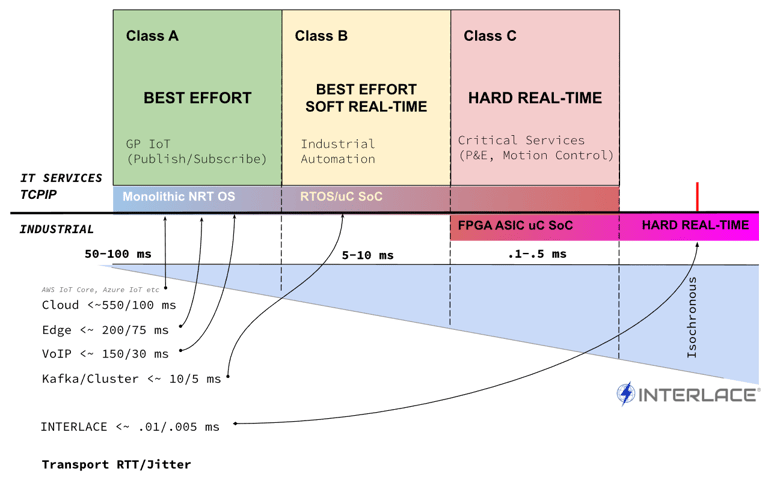Industrial Ethernet Transport
Traffic Classifications & Design Considerations
6/16/20252 min read
This section provides an overview of Interlace and the most important Industrial Ethernet Technologies and how our network connects them.
There are two key components to a communications network:
predictability and
deterministic
Depending on the real time needs of the device and cost requirements of the project and applications, technologies follow different principles or approaches. This comparison groups them by three different classes with respect to the slave device implementations:
CLASS A
Class A uses standard, unmodified Ethernet hardware as well as standard TCP/IP software stacks for process communication.
Cloud based IoT networks are in this class, they are best effort. Some implementations may have modified "tuned“ slave TCP/IP stacks (RTOS Linux patch e.g.) to provide try to better performance. This is why they deploy protocols like Publisher/Subscribe - these have only one QoS "best effort".
The real-time performance is limited by unpredictable pdv's (packet delay variations) end-to-end over different carrier infrastructure components like switches, routers, load-balancer's etc – due to the fact there is other traffic on the network. Networking equipment have Tx/Rx queues and will be more efficient with the use of L1/2/3 cache to facilitate the switching which allows them to get through the queues quickly.
When you have a cache miss, this means general memory access is slow. When this is combined with the biggest problem to better real time performance, a non-real-time OS slave and software stacks (TCP/UDP/IP), the design engineer needs to be on their toes.
Real-time performance is not just about speed but determinism, and that is why we, in the industry, have two types of real-time performance; hard and soft.
While IT use the terms "real-time" or "near real-time" it's just marketing fluff and not what were talking about here.
CLASS B
Class B approaches still use standard, unmodified hardware, but do not use TCP/IP for process data communication. A dedicated process data protocol is introduced, which is transported directly in the Ethernet frame.
TCP/IP stacks may still exist, but typically their access to the Ethernet network is controlled and limited by what can be considered a timing layer.
Of course this description is pretty generic – but more details are given in the technology specific sections.
CLASS C
Class C approaches aim even higher with regard to performance. In order to achieve these goals, dedicated hardware has to be used (at least on the slave device side).
In some cases a special Real-time Ethernet Controller is more a Special Switch Device – but the result is the same: better performance due to better hardware integration e.g. PROFINET IRT.
This does not exclude the use of TCP/IP and the Internet Technologies, but it's very difficult even with patched kernels, mainly because of power management throttling, as the kernel is driven in a free-running mode. The cooling and various other sub-systems are also a design consideration.


Private and Secure Global Network
© 2025. All rights reserved.


